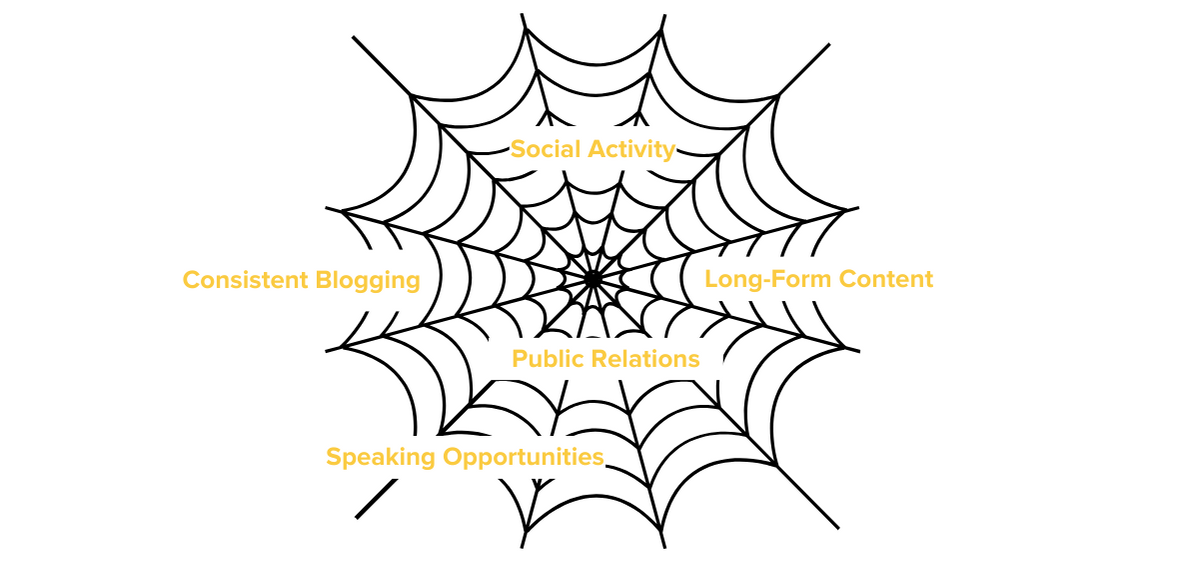
The Spider Web Effect of Thought Leadership
The Spider Web Effect of Thought Leadership
Kelsey Raymond, COO • Intero Digital • September 29, 2022

Communicating your company’s credibility and expertise is critical for your team’s branding and long-term growth efforts. And the key to developing and executing a strategy that positions you as a thought leader in your industry requires your understanding of exactly what your audience is looking for in its leaders.
Whether intentionally or subconsciously, most people run through a checklist in their minds to distinguish standard vendors and service providers from influential, credible companies and business leaders. To determine your trustworthiness, people examine your:
- Level of industry expertise
- Understanding of customer challenges and pain points
- Transparency in communication and expectations
- Ability to deliver on your company’s promises
- Validation by external publications
- Consistency in creating and distributing quality content
Unfortunately, many company leaders mistake speaking events or blog posts every few months for comprehensive thought leadership strategies that can achieve each of these objectives. But in reality, each speaking event and blog post should just be one piece of a much larger strategy.
While these smaller pieces of your strategy aren’t bad or completely ineffective on their own, they’re also not going to help you single-handedly build a long-term platform to guarantee your target audience will find and trust you.
Lorem ipsum dolor sit amet, conse ctetuer adipiscing elit, sed diam nonum nibhie euismod. Facilisis at vero eros et . Lorem ipsum dolor sit amet, consectetur adipisicing elit, sed do eiusmod tempor incididunt ut labore et dolore magna liqua. Ut enim ad minim veniam quis nostrud exercitation ullamco laboris nisi ut aliquip ex ea commodo consequat. Lorem ipsum dolor sit amet, conse ctetuer adipiscing elit, sed diam nonum nibhie euismod. Facilisis at vero eros et . Lorem ipsum dolor sit amet, consectetur adipisicing elit, sed do eiusmod tem.
The Spider Web of Thought Leadership

A great way to describe how thought leadership actually works is to compare it to the construction and function of a spider web. Just like each strand of web is carefully woven in just the right places for a spider to capture what’s necessary for it to survive, an effective thought leadership strategy requires a business leader to create content and to strategically align each piece with the overall message to attract and nurture a targeted audience.
Each strand of that web is a specific tactic you use to engage your audience and guide them through their buyer’s journey. And while each tactic serves a unique purpose in your strategy, all of them collectively focus on sharing relevant expertise through specific platforms your audience is engaged with.
Here’s a hypothetical example:
Let’s say you’re a tech company. If your goal is to target business executives and entrepreneurs in the tech industry with your expertise and unique insights about technology, you’d need to prioritize publishing content to niche publications like Re/Code, ITProPortal, and Tech.Co — publications your audience is already reading for news and trends.
To complement these efforts and draw your audience closer to the center of your web, you’d also need to consider publishing to more general, but still focused, business publications like Inc. and Entrepreneur (and on an internal publication like your company blog).
Each publication and every piece of content are a part of your larger overall strategy to attract, engage, and educate a targeted audience and draw members of that audience closer to the center of your web.
5 Key Strands of an Effective Thought Leadership Web
While a consistent stream of guest-contributed content in niche publications is necessary to build your web, there are also other important platforms for communicating your expertise to capture as many members of your audience as possible.
Other strands to weave into your thought leadership strategy include:
- Consistent Blogging: If lead generation is a high priority for your company, then an active blog filled with relevant, compelling content in an absolute must.
- Long-form Content: Special content projects like whitepapers and e-books allow you and your company to really dive deeper into important industry topics than traditional blog posts.
- Social Activity: True thought leaders are passionate about the topics they discuss, and by sharing your ideas and ideas of those you trust and respect on social media, you can build a following, humanize your brand, and show others how passionate you really are about these topics.
- Public Relations: Contributing content to leading industry publications, consistently blogging, creating long-form content, and establishing a loyal following on social media can make you more attractive to other leaders in the industry. This relationship can help earn you PR opportunities, press mentions, and even quotes in content from other thought leaders.
- Speaking Opportunities: While speaking opportunities are harder to come by, they’re a great way to add a face to your words and build deeper long-term relationships with members of your audience. Our COO Kelsey Raymond has been a speaker at many conferences, and it’s shown to be incredibly successful in networking with partners and prospective customers. Just keep in mind that to garner these high-profile speaking opportunities, it usually comes as a result of effectively executing other efforts.
Your goal should be to make yourself visible, authentic, and trustworthy to members of your audience, and you can do this by publishing to a publication they’re reading, speaking at a conference they’re attending, or sharing a blog post they find in their online research. Above all, remember that this web is built around your insights and expertise, and executing it depends on your ability to create and deliver high-quality and resourceful information your audience is seeking.
